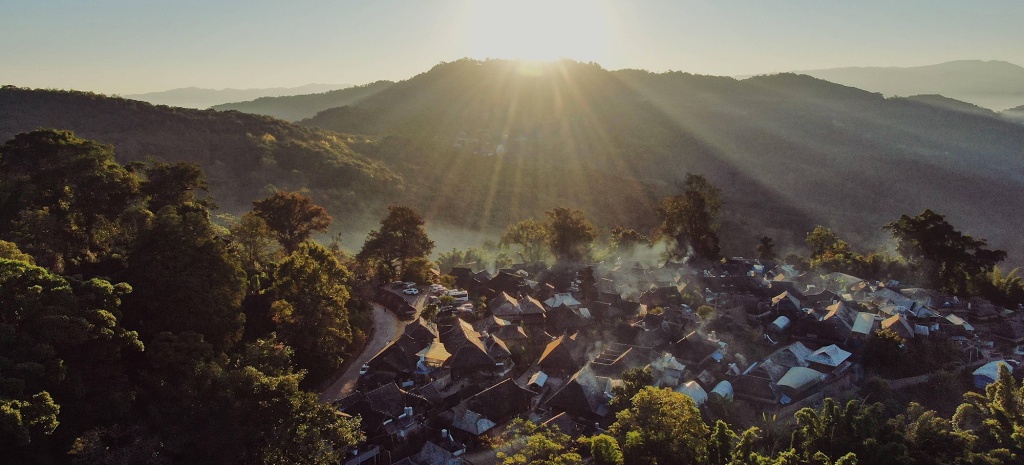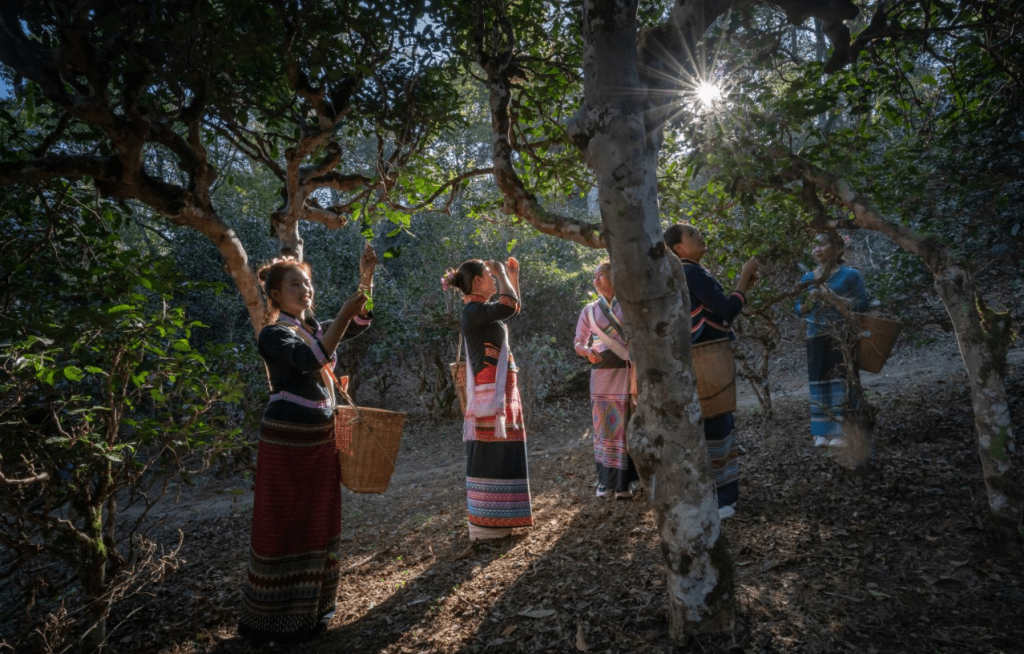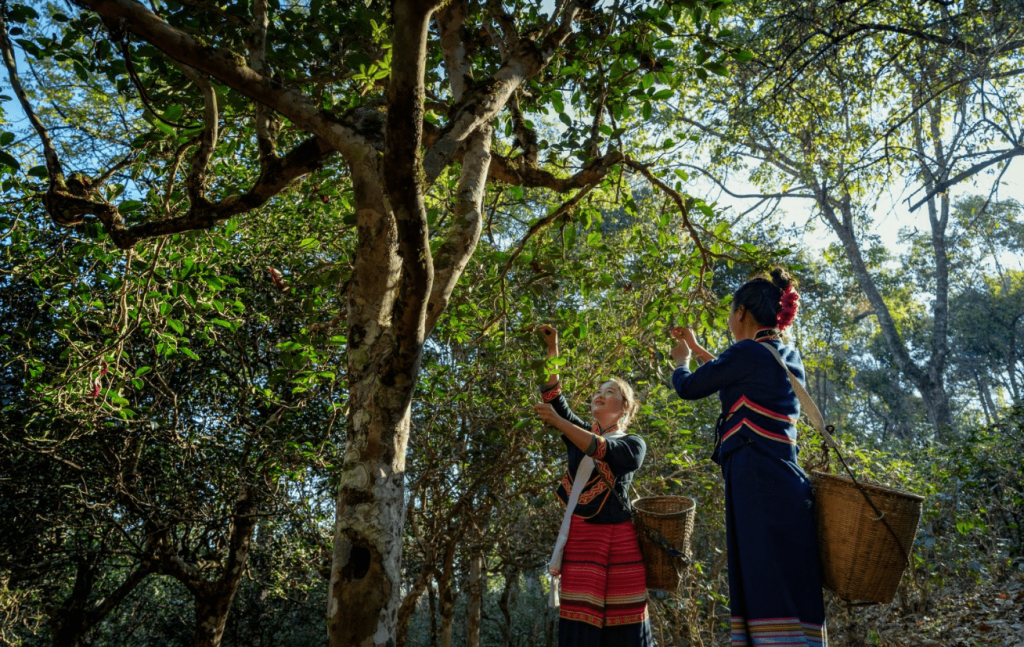Tea Region "Jingmai"
Jingmai Mountain is the birthplace of tea and one of the six major tea mountains in China. This mountain is home to the oldest and largest cultivated ancient tea garden in the world, which has witnessed the development of Chinese tea culture. Jingmai Mountain is famous for its long history of producing high-quality Pu'er tea.
Among the 12 Great Tea Mountains, Jingmai (Chinese: 景迈, pinyin: jǐng mài) occupies a leading position. The total area of the province's region is 28 thousand mu, of which tea trees occupy 10 thousand mu, so it is rightly called the "10,000 mu tea garden" (Chinese: 万亩乔木古茶园, pinyin: Wàn mǔ qiáomù gǔ cháyuán). The garden is located on the territory of Lancang County (Chinese: 澜沧县, pinyin: lán cāng xiàn), Huiming Village and two village committees of Manjing (Chinese: 芒景, pinyin: Máng jǐng) and Jingmai, which are considered the birthplace of Pu'er tea. Manjing is inhabited mainly by the Bulang people, Jingmai by the Dai people. The county is called the "natural museum of tea." The highest quality product is made from the raw materials of the Huangjing area (Chinese: 黄金, pinyin: huángjīn).

The total area of plantations is 16,173 mu, with an elevation in the northwest and a decline in the southeast. The highest point is 1,662 m, the lowest is 1,100 m above sea level. The territory belongs to the mountainous region of the subtropics with a monsoon climate with a clear division of dry and wet seasons. The average annual temperature is 18 degrees, the annual rainfall is 1,800 mm. It is written on the stone steles of the Manjing Monastery that in the 57th year of the Dai calendar, tea trees were planted, which then began to be used as raw material for pu-erh . During the Yuan Dynasty (1280-1367), tea began to be sold to Myanmar, Thailand and other countries of Southeast Asia. This tea forest is very unusual - a large crown, lush foliage, many parasitic plants - giving it an amazing appearance. Because of this, many researchers and tea experts call it a museum of the history and culture of tea.
The Legend of Pa Ailen
According to legend, more than 1000 years ago, the ancestors of the Dai people moved to this area, chasing a deer, which led them to the Jingmai Mountains. Seeing lush forests and fertile soil, they decided to settle here. The ancestor of the Bulan people named Pa Aileng (Chinese: 帕哎冷, pinyin: pà āilěng) was passing by these places and saw a tree from which he prepared a medicine that saved him from an illness. He considered this a sign from above and God's grace, and subsequently entered the area with troops and founded settlements. Before his death, he addressed his descendants with words that later went down in history: "I left you gold that you can spend, I left cows and sheep that can die from illness, and only the leaves of this tree will never end." In the annals of the Dai people, there is a legend: the elder of the Dai people gave the seventh princess in marriage. Nowadays, the Pa Aileng Temple and the Pavilion of the Seventh Princess in Jingmai are reminiscent of these legends. Historians have found information in the book “Manshu” (Chinese: 蛮书, pinyin: mán shū) and records kept in the Jingmai monasteries about events in the early seventh century, when there were large-scale tea plantations here, which are now about 1,400 years old. According to sources of the Bulan people, the history of tea cultivation in this region begins at the end of the Eastern Han Dynasty (180 BC), that is, it already has a history of 1,835 years. In 2012, the ancient tea gardens of Jingmai were included in the list of protected sites of the UNESCO World Agricultural Heritage. The settlements on Mount Jingmai have a special form of huts on trees and seem to be part of the forest.
Even now, a large number of ancient trees have been preserved in the tea forests. The total area of the tea garden is about 1,231 hectares, the density of forest plantations is 1,000 trees per 1 hectare. Thus, in these forests there are more than 1,200 thousand trees in a large-leaved deciduous forest, growing luxuriantly on gentle slopes. The height of the tea trees is 2-5 m, the trunk circumference is 12-30 cm, the crown diameter is 2-6 meters. Individual trees reach a height of 12 meters, and the crown diameter is 12 meters.
The Bulang people, and then the Dai, began to cultivate tea here. Because trees of a certain age (about 100 years) are used to produce pu'er, a period of low productivity and decline gradually sets in, so ancient forests are constantly being renewed. According to a report by the Institute of Plant Industry of the Chinese Academy of Sciences, the oldest trees were found in the city of Kunming, in the villages of Manjing, on the back slope of Manhong and Dapingzhang (Chinese: 大坪掌, pinyin: dàpíng zhǎng) their age exceeds 300 years. There are quite a lot of 100-year-old trees, in addition to them, 9.8% are trees 100-150 years old and more than 0.7% are older than 150 years. Old trees usually have many parasitic plants. Usually parasitic plants of the family of Strap-flowered, such as the Bunge chestnut, popularly called "crab paws", there are plants of the heather family (ericaceae) 10-30 cm high. They are especially visible during the flowering period in November. Although the Jingmai tea plantations have a thousand-year history, ancient trees are replaced by new ones and form a single ecosystem. In 2017, the volume of dry tea collected exceeded 400 tons. On the territory related to the heritage (Chinese: 遗产申报区, pinyin: yíchǎn shēnbào qū) there are 33 factories, 42 peasant cooperatives that work according to uniform standards, protecting the ecological situation and the purity of plantations.
Jingmai is the birthplace of tea.
In the 1970s, a tea tree fossil from the third period of the Oligocene Epoch, a late Tertiary period of the Miocene Epoch, and other specimens over 2,500 years old were discovered in the protected area of Pu'er City. The thousand-year-old trees represent an intermediate form between wild and cultivated plants, beautifully illustrating the evolutionary process.
As they say in China, “There is the Silk Road in the north, and the Great Tea Road (Chinese: 万里茶道, pinyin: wànlǐ chádào) in the south.” Both are famous throughout the world. The Tea Road is associated with Pu’er, and its heyday dates back to the Tang and Song dynasties. It was also called the Southern Silk Road, and was a channel for the migration of peoples, the development of trade relations, the penetration of religion, and the enrichment of cultures. The places where Pu’er tea grows have always been centers of trade, and well-preserved traces of the Tea Road still remain.

Features of Jingmai tea.
There is a saying in the tea world: Sweetness of Jingmai, softness of Yiwu, cloyingness of Banzhang, liveliness of Bingdao . These characteristics describe the characteristics of the four famous puer regions with amazing accuracy.
The standard of quality of Jingmai Mountain tea is a sweetness that is different from the sweetness of carbohydrates and sugars, after which comes acidity, and different from the sweetness of the famous green tea of Jiangnan Province, and not even similar to the so-called belated sweet aftertaste of tea from ancient trees. It is a sweetness that is born from the combination of thick and pure taste.
The first sip of the drink already gives a cool refreshing sweetness, the taste lingers, leaving a shimmering aftertaste and sweetness on the tip of the tongue. From a scientific point of view, this sensation is, on the one hand, due to polysaccharides, and on the other, to sweet amino acids. Studies have shown that the content of polysaccharides and amino acids in tea leaves from ancient Jingmai trees is significantly higher than in products from other regions. At the same time, the content of tea polyphenols is low. The ratio of phenols to ammonia is low, which is the main biochemical indicator of high quality green tea.
The tea infusion is yellow-green, the taste is thick, and the aftertaste is long and sweet. It is said that this tea draws the power of heaven and earth, sun and moon.
Another feature is that the trees are not pruned, the leaves are of different sizes, there are large, medium and small leaves. The tea has a distinct aroma with a strong note of wild tea. Because tea trees grow in a mixed forest, the tea has a wild forest aroma, especially persistent and natural, with a predominant note of orchid.
.
Sweet taste is a feature of tea that is difficult to fake. Usually, sweetness appears after bitterness as a sweet aftertaste, but in this drink, the sweetness is immediate and long-lasting. It is better to drink such tea before noon, at noon it can change the taste of food, at night it will keep a long aftertaste in the mouth. Raw materials from the Jingmai region are astringent with a low degree of bitterness.
There are three aromas in Jingmai Mountain tea. The first is that the orchid aroma is clearly felt in dry tea, which moves into the infusion, remaining for up to 10 steeps. The tea bottom has the same aroma, it clearly expresses the melody of wild ancient tea, this is associated with the fact that the tea grows in a mixed forest. The aroma is a distinctive feature of Jingmai tea and one of the reasons for its popularity. The strength and durability depend on the time of harvesting: spring tea is the most aromatic, autumn tea is the least. For Jingmai Mountain tea, the rule is: the more tender the leaves, the stronger the aroma.

Eight Major Villages of Jingmai and Manjing
1. Mangen (Chinese: 芒埂村, pinyin Mánggěng cūn)
The village is located in the northeastern part of Jingmai, close to a ridge line, with buildings arranged in tiers from south to north. Mangen is located near Mengben village and is similar in its heart-shaped arrangement of buildings. In the center of the village is the Sadi Temple (Chinese: 萨迪, pinyin: Sàdí) and burial mounds, with the Jinshuitang Reservoir (Chinese: 金水塘, pinyin: Jīnshuǐ táng) nearby. This arrangement of important sites speaks to the traditions of the Dai people and their close ties to water.
2. Mengben (Chinese: 勐本村, pinyin Měng běncūn)
It is located in the northeastern part of Jingmai, adjacent to Mangen, near the northern part of the ridge. The buildings are arranged in tiers and form a heart shape. The Buddhist monastery of Jinta (Chinese: 金塔, pinyin: Jīntǎ) is located at a distance from the center.
3. Jingmai dazhai (Chinese: 景迈大寨, pinyin: Jǐngmài dàzhài)
Situated on the northern slope of Jingmai, due to rapid economic development, the village has many new buildings, arranged in tiers and facing northeast. In the center is a Buddhist temple, with streets branching off from it. There are many burials in the eastern part of the village. The great tea road ran through the southwest.
4. Nogan (Chinese 糯干, pinyin Nuògàn)
It occupies the northwestern slope of Mount Jingmai. It is one of two ancient villages that have retained their original appearance, building appearance and structure. It is mainly located in a gorge, and at a sufficient height in the northern and southern parts. It is an example of a centric village structure, in which there is a center, the temple is located at a distance at a height. Here, streams and lakes gather, forming a water system, which is the main structural factor.
5. Upper Manjing (Chinese: 芒景上寨, pinyin: Máng jǐng shàng zhài)
Situated in the centre of the southern Jingmai Mountains, inhabited by the Bulan people. In the northwestern part there is a temple built in honour of the Bulan ancestor Pa Aileng (Chinese: 帕艾冷, pinyin: Pà àilěng). This is the main religious site among the nearby villages. At the northernmost point grows the Fengshen tree (Chinese: 蜂神树, pinyin: Fēngshén), a hundred-year-old banyan tree revered by the Bulan people. The village has a centric system - in the centre there is a spring and a banyan tree in memory of the seventh princess (Pa Aileng's wife).
6. Lower Manjing (Chinese: 芒景下寨, pinyin: Máng jǐng xià zhài)
It is located in the center of the southern part of the Jingmai Mountain inhabited by the Bulan people, south of Upper Manjing. At the eastern end of the village there is an old cypress tree, to the north there are the ruins of the Balan settlement (Chinese: 巴郎, pinyin: Bā láng), the tomb of a princess and other important places for the Bulan people for festive worship and offerings. This is the place where the most evidence and legends related to the ancestors of the Bulan and the culture of pu'er in this area have been preserved. Between Upper and Lower Manjing there is the Manjing Tea Museum.
7. Manhong (Chinese: 芒洪村, pinyin: Máng hóng cūn)
Manhong Village is located at the southern end of Manjing, and is home to an octagonal pagoda, a symbol of Buddhism. The village has a centric structure, with a worship stone in the center. This structure is explained by the Bulan belief that the spirit of the center protects the people. The sacred tree here is the "royal tea tree." This is an example of the cult of nature and worship of the forces of nature, which is typical of this people.
8. Wenji (Chinese: 翁基村, pinyin: Wēng jī cūn)
The second village along with Nogan, where the original appearance of the ancient village is preserved, at the northern point is a place of faith - the ancient temple of Wenji (Chinese: 翁基, pinyin: Wēngjī). It is the oldest Buddhist temple in the Jingmai Mountains. Next to it is a 20 m high cypress tree with a root circumference of 11 m. It is estimated to be between 2,000 and 3,000 years old. This tree is as revered as the temple. The village has a centered structure, denser construction in the north and more sparse in the south.

Jingmai Mountains is the birthplace of tea treasure.
In 1950, a representative of the national minorities personally presented Chairman Mao with the most precious gift – a bag of Xiaoqué Zuijian tea (Chinese: 小雀嘴尖茶, pinyin: Xiǎoquè zuǐjiān chá) from this area at the anniversary celebration of the founding of the People's Republic of China. In 2008, at the Beijing Olympics, tea from Jingmai was used for official ceremonies.
Prices for tea raw materials from the Jingmai region have been constantly rising in recent years.
2017 — first spring harvest from ancient trees 1000-2500 yu/kg, first spring harvest from small trees 300-1000 yu/kg.
2016 – first spring harvest from ancient trees 1600-1800 yu/kg.
2015 - harvest from ancient trees 800 yu/kg
2014 – spring harvest from ancient trees 800-1500 yu/kg.
2012 - mixed spring harvest 280-350 yu/kg
- Comments
- Vkontakte






